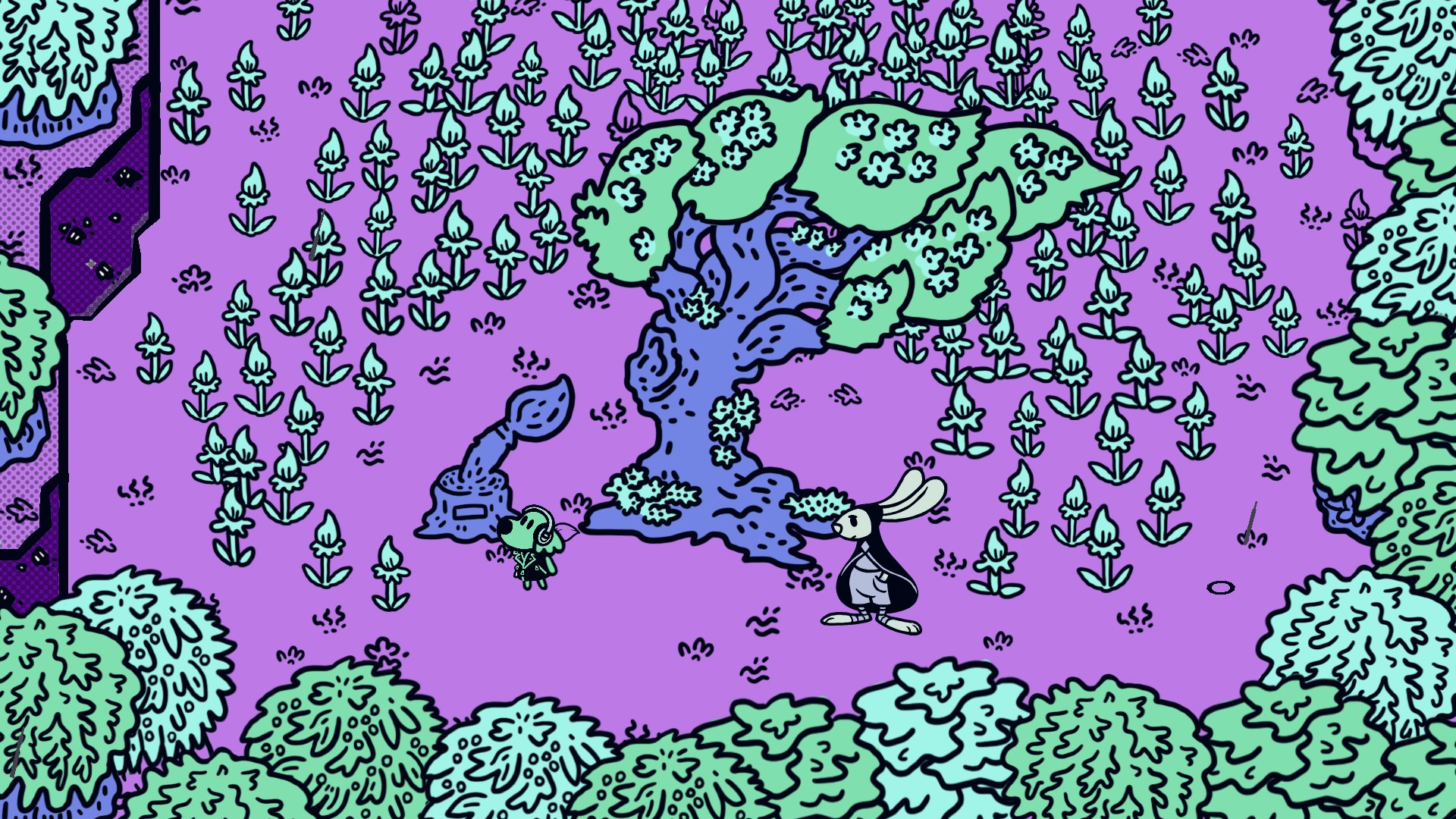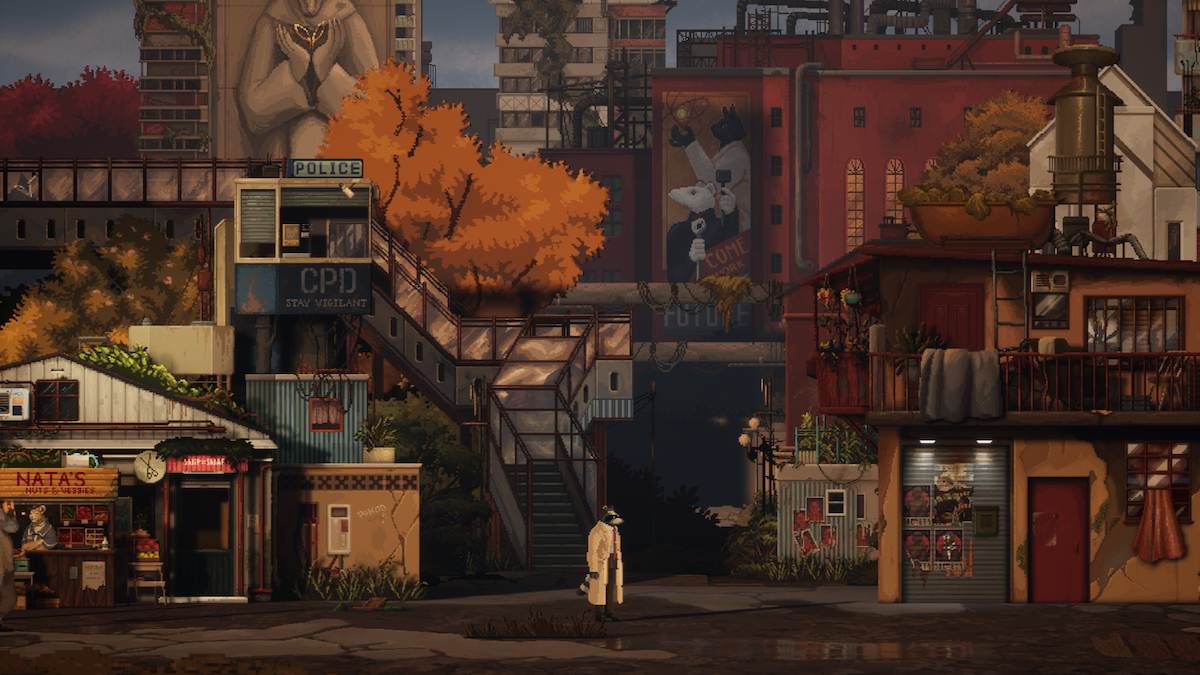On first glance, Chicory: A Colorful Tale looks almost indistinguishable from many current indie gaming releases. With its bubbly art style, cute animal characters and an overworld that looks like it could be ripped straight out of a Gameboy-era Zelda game, it might be easy to shrug the game off as yet another hackneyed attempt at capitalizing on Nintendo nostalgia of the 1990s. However, Chicory is easily one of the most unique games of the last few years due to its blend of artistic direction and gameplay.
In Chicory, the newest game from Wandersong developer Greg Lobanov, you play as Burger, the loyal janitor to Chicory. The titular rabbit is a wielder—a trained artist who uses a tool known as “the brush” that is passed down from generation to generation and used to color the world (think Avatar: the Last Airbender for Picasso fans). One day, the world of Picnic is robbed of all its color. Burger stumbles upon the brush and becomes the new wielder, despite not having any formal artistic training. As part of this new role, she must restore color to Picnic and defeat the evil corruption that’s spreading throughout the world.
Picnic is quite literally a blank canvas—the world is entirely black-and-white with shadows and textures distinguished with dithering rather than using actual grays—and you can color anywhere on the screen with the brush. Some objects you can fill in by just tapping them, and the cartoonish, thick-lined artwork by artists Alexis Dean-Jones and Madeline Berger makes the Pacific Northwest-inspired landscape of Chicory’s overworld feel like an interactive coloring book. Your brush is controlled by either a mouse cursor or a control stick, depending on the setup you’re using. However, despite being primarily marketed for the PlayStation 4 and PlayStation 5, the best way to play Chicory is on a computer with a keyboard & mouse. It runs smoothly with great performance in all areas except where water is present, but the tradeoff is more than worth it for the precise mouse control while painting.
One of Chicory’s interesting artistic design choices is the restrained color palette. While the game could have allowed you to use a wide variety of colors, your brush is limited to four colors at any given time, which cycle depending on the area, though there is one NPC who will give you permanent colors to use. In the murky Gulp Swamp, your colors switch between washed-out greens and grays, while up on Dessert Mountain, you’re given a palette of light blues and purples to match the snowy theme of the mountain’s peak. This allows each area of the overworld to feel distinctly different regardless of how you color the map, and also meshes well with Chicory’s theme of artistic imperfection. The colors in each area rarely match up with how the area should look, with the unique palette allowing your own color work to feel like an abstraction rather than a realistic depiction of the landscape.
While the main campaign can be beaten in a manner of just six or seven hours, you’ll likely spend much more time dwelling in the world of Picnic, which is segmented into equally-sized screens across a large grid. Taking time to color in screens and absorb the fulgent landscape of your own creation acts as a nice breather in-between Chicory’s ten rapid-fire story chapters. Outside of some swift sidequests, Chicory refuses to bog down the player with excessive gameplay or meandering design. You rarely have to tread through areas more than once, and each story chapter takes place in a completely different zone of the overworld. The result is a plot with practically zero filler, and the variety of side activities—whether that’s delivering mail to dwellers throughout Picnic, solving the mystery of stolen resort furniture or simply coloring in one of the game’s hundreds of different screens—helps break up the pacing.
Despite how much optional content is littered throughout the overworld, it’s clearly communicated to the player that they shouldn’t feel the need to complete everything there is. It helps that the game’s collectibles are littered in as small, optional objectives for the many puzzles required for completion. Most screens contain a puzzle, and each puzzle has a solution that allows you to venture further out into the world, but most puzzles have an additional secondary solution that’ll reward you with a collectible, whether that’s a new piece of clothing (Chicory’s primary collectible and method of customization) or a piece of litter, which can be exchanged for various types of decor. There’s a lot of intrinsically rewarding things to do as well—outside of coloring in screens, scattered throughout the overworld are benches, chairs and dwellings where you can sit to simply enjoy the view and indulge in the masterful penwork—and your masterful coloring—for a little while.
With its simple but creatively freeing mechanics, in the wrong hands Chicory could have ended up just being Scribblenauts for coloring book aficionados, but the game has a wonderful narrative to back up its relaxing gameplay. It’s a bit hard to not compare Chicory with 2018’s Celeste—both were inspired by old-school Nintendo games, were developed by teams from Vancouver, BC and have a killer soundtrack composed by Lena Raine—but that comparison is a wholly positive one, and, just like Celeste, Chicory is able to blend the themes of its narrative with its mechanics in a manner that’s impossible not to appreciate.
As Burger, you must get rid of a strange and dark corruption that’s spread across the world of Picnic, with thick roots of a massive, evil tree stretching throughout the entire overworld. It doesn’t take long to realize that this corruption is the manifestation of fears of an artist—the strive to be perfect, the negative emotions of self-doubt and frustration come to life. Each chapter has some kind of dungeon where you complete various puzzles, leading up to a boss fight against an expression of these negative emotions, each of which feel extremely distinct and unique in their mechanics. Although Chicory doesn’t feel very original in its puzzle or world design, there’s nothing else quite like it’s boss fights, which feel like a delightfully psychedelic mix of osu! and Undertale.
The creative elements of the game feel a bit rugged at times, with your brush locked to three different sizes and splotchy strokes preventing you from painting your impressionist masterpiece across the landscape; however, these limitations align perfectly with the story’s theme of being an imperfect artist. In your first hour or two, it’s easy to get frustrated by the inability to focus on little details, making the artistic process feel lackadaisical and arduous. After enough time, though, you’ll approach every screen with a joyful and reckless brush and bucket, leaving no stone unturned in your quest to restore color to the black-and-white world of Picnic.
At the end of each chapter, you also obtain a new ability that allows you to explore previously inaccessible areas of the world, such as being able to jump or swim through your paint a la Splatoon. Due to the unique form of these traversal mechanics, it becomes more efficient to bathe the world in color rather than to waste time attempting to be precise. The ability to freely paint at almost any time—including during cutscenes—makes decorating the world with color a complete joy.
Chicory: A Colorful Tale is a testament to the power of creativity and artistic expression, and every inch of its world is full of beauty—painted or not. Its simple mechanics are a delight to play with and its quaint and quiet world is a pleasure to explore. If a picture is worth a thousand words, then the world of Chicory is a sweeping, poetic novel the likes of which its genre has never seen before.





